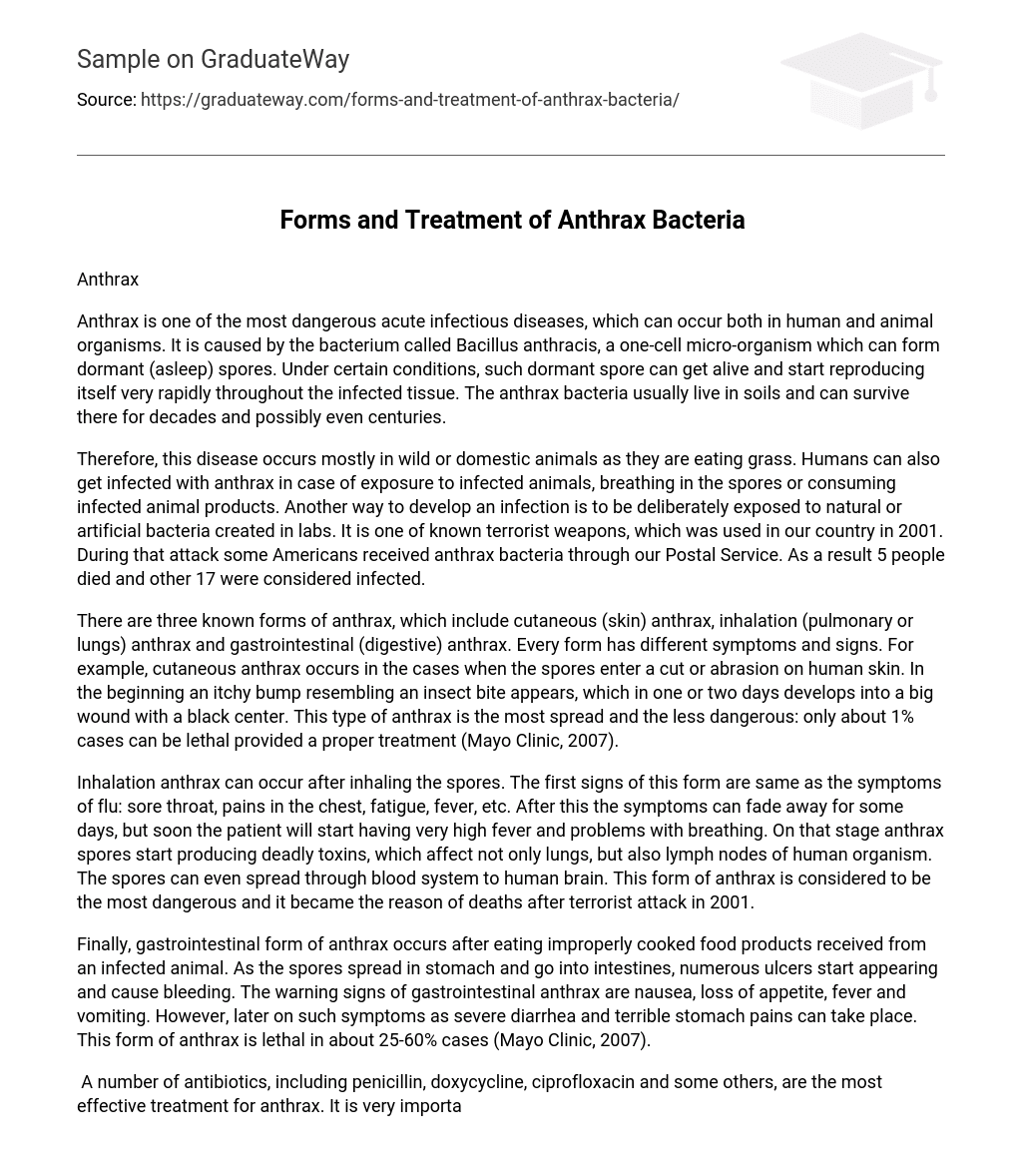Anthrax is one of the most dangerous acute infectious diseases, which can occur both in human and animal organisms. It is caused by the bacterium called Bacillus anthracis, a one-cell micro-organism which can form dormant (asleep) spores. Under certain conditions, such dormant spore can get alive and start reproducing itself very rapidly throughout the infected tissue. The anthrax bacteria usually live in soils and can survive there for decades and possibly even centuries.
Therefore, this disease occurs mostly in wild or domestic animals as they are eating grass. Humans can also get infected with anthrax in case of exposure to infected animals, breathing in the spores or consuming infected animal products. Another way to develop an infection is to be deliberately exposed to natural or artificial bacteria created in labs. It is one of known terrorist weapons, which was used in our country in 2001. During that attack some Americans received anthrax bacteria through our Postal Service. As a result 5 people died and other 17 were considered infected.
There are three known forms of anthrax, which include cutaneous (skin) anthrax, inhalation (pulmonary or lungs) anthrax and gastrointestinal (digestive) anthrax. Every form has different symptoms and signs. For example, cutaneous anthrax occurs in the cases when the spores enter a cut or abrasion on human skin. In the beginning an itchy bump resembling an insect bite appears, which in one or two days develops into a big wound with a black center. This type of anthrax is the most spread and the less dangerous: only about 1% cases can be lethal provided a proper treatment (Mayo Clinic, 2007).
Inhalation anthrax can occur after inhaling the spores. The first signs of this form are same as the symptoms of flu: sore throat, pains in the chest, fatigue, fever, etc. After this the symptoms can fade away for some days, but soon the patient will start having very high fever and problems with breathing. On that stage anthrax spores start producing deadly toxins, which affect not only lungs, but also lymph nodes of human organism. The spores can even spread through blood system to human brain. This form of anthrax is considered to be the most dangerous and it became the reason of deaths after terrorist attack in 2001.
Finally, gastrointestinal form of anthrax occurs after eating improperly cooked food products received from an infected animal. As the spores spread in stomach and go into intestines, numerous ulcers start appearing and cause bleeding. The warning signs of gastrointestinal anthrax are nausea, loss of appetite, fever and vomiting. However, later on such symptoms as severe diarrhea and terrible stomach pains can take place. This form of anthrax is lethal in about 25-60% cases (Mayo Clinic, 2007).
A number of antibiotics, including penicillin, doxycycline, ciprofloxacin and some others, are the most effective treatment for anthrax. It is very important to identify the disease on early stages and start treatment immediately. For all three forms of anthrax the treatment course usually lasts 60 days, during which doctors can use above mentioned antibiotics or their combination. In cases of inhalation anthrax patients are usually taken to hospital and treated with intravenous antibiotics. In other situations oral antibiotics can be effective.
Antibiotics are also recommended as an effective medicine to prevent anthrax for those people, who are suspected to be exposed to anthrax bacteria. Another effective way to prevent disease is a special anthrax vaccine, which can be administered to those people, who can be possibly exposed to the bacteria: for example, military personnel or lab workers, etc. In our country this vaccine is not available for general public.
Anthrax can not be spread from one person to another, therefore, there’s no need in isolating of an infected person. But, undoubtedly, in order to keep out of danger to develop the infection it is necessary to be very careful and cautious when dealing with livestock or unchecked animal products, avoid eating undercooked animal products, as well as to make every effort for keeping our environment clean and healthy.
References
- Anthrax. (n.d.). Center for Disease Control and Prevention. Department of Health and Human Services. Retrieved June 21, 2007, from <http://www.bt.cdc.gov/agent/anthrax/index.asp>.
- Anthrax. (2007, June 8). Mayo Clinic. Mayo Foundation for Medical Education and Research. Retrieved June 21, 2007, from: <http://www.mayoclinic.com/health/anthrax/DS00422>.





